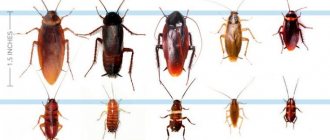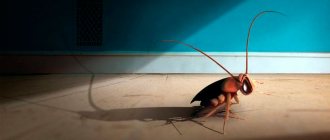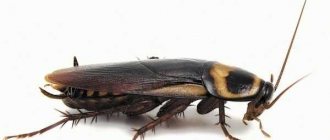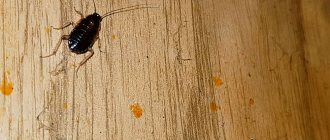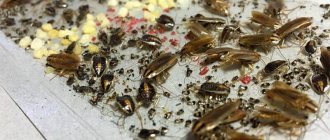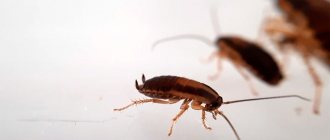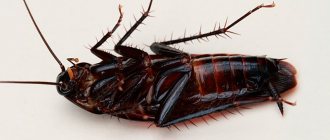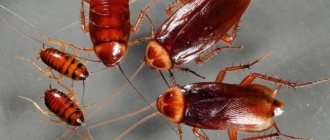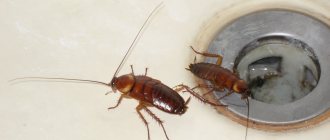Some people believe that cockroaches are flying insects, others are sure that they are crawling pests. Each statement is true in its own way. Let's find out, do cockroaches fly? Find out more about these insects.
Let's start with the fact that the cockroach order has over four and a half thousand species, among which there are both flying and flightless cockroaches. In some species, the presence of wings and the ability to fly also depend on gender. So the answer to this question will vary depending on what specific type of cockroach we are talking about.
Are there flying cockroaches?
Perhaps people don’t know as much about any insect as they do about cockroaches. Everyone has seen it live in their kitchen or somewhere else, obviously not in a photo on the Internet; myths and scary tales are made up about its ability to survive and its adaptation. But for some reason, when it comes to his ability to fly, everyone begins to doubt. Strange, isn't it?! Cockroaches, like almost all insects, have two pairs of wings. In front are the so-called integumentary wings, which cover the delicate part of the hind wings. Both pairs are needed for flight. But whether there are flying cockroaches, whether cockroaches can jump high remains a subject of debate and controversy.
The structure of insects
All representatives of the cockroach order have a similar structure. They consist of three main parts: head, chest and abdomen. The body is flattened, oval. Length ranges from 9-95 mm. The head is triangular, covered from above by the pronotum. The mouthparts are of a gnawing type, directed downwards. The antennae are long and bristly. Elytra with wings and 3 pairs of limbs are attached to the chest segments. The abdomen is elongated, flat, with clearly visible segments.
The larvae are a smaller copy of the imago. Their distinctive feature is the absence of wings. The offspring acquires an organ after changing several ages and moults, upon reaching puberty.
Insects have two pairs of wings located on the chest segments. As a result of evolution, the first one turned into leathery elytra. They do not take part in the flight. When at rest, they fold compactly on their backs, in some cases partially overlapping each other. The organ performs an integumentary function. The hind wings of cockroaches are a thin chitinous plate with veins and trachea. They are webbed and fold like a fan.
Red cockroaches
Mostly red and black cockroaches live in apartments. Getting an accurate answer to the question of whether cockroaches have wings is very simple. All you have to do is go out hunting at night, catch it and see. Happy owners of apartments without cockroaches can look at the photo. The red cockroach has wings, but lacks flight skills.
Red cockroaches have fairly developed wings. On rare occasions, red cockroaches use them for brief gliding, such as when they fall out of a refrigerator or fall off a wall. According to some reports, Prussians fly during wedding celebrations. But this is not entirely true. To attract males, females spread their wings and strike hard, which is why they create the illusion that cockroaches can fly.
Prussians are the most common of all cockroach species. Their high breeding rate makes them a direct threat to your family and home. All it takes for a global infection is one female that gets into your home.
Between her and her offspring, more than 30,000 cockroaches can be produced in one year, although many of them will not live very long. Those that survive are more than enough to cause sickness and disgust. In each case, a red cockroach's clutch may contain between 20 and 40 young, and unlike other cockroach species, the adult female carries the eggs with her until they are ready to hatch. This makes them extremely persistent and difficult to get rid of.
Interesting!
By the size of the wings, the female is easy to distinguish from the male, because they are noticeably shorter.
The Cossack boy sent into the house is a red-haired, mischievous little Russian
The first meeting with him can happen anywhere: in an apartment, in a store, in a dining room or cafe. There is probably no person who has not seen an insect with his own eyes. The red Prusak cockroach multiplies quickly, and all of Europe already knows it. Thanks to the ability to adapt to new conditions, the families number more than 4,000 species.
Why are cockroaches called Prussians? The insect got its origin and name from Prussia, because it was from there that soldiers under the leadership of Napoleon brought them home. But oddly enough, in Germany they are usually called Russian cockroaches, hares. There is another name we have adopted - stasiki.
to contents
Black cockroaches
Oriental cockroaches are shiny black or dark reddish brown in color. Male black cockroaches grow up to 2.5 mm in length; smaller males have shortened wings that are three-quarters long. As a result, the last few abdominal segments of their body are exposed.
In comparison, female black cockroaches reach a length of 3.2 cm and do not have any wings. Instead, they have large wing flaps that protect the first few segments of their bodies. Differing in appearance, neither males nor females can fly.
Fighting methods
“The cockroaches have moved in, but they don’t want to move out,” an apt phrase from the legendary blockbuster “Men in Black” very accurately reflects the essence of these insects. Prussians are able to survive a nuclear explosion, so it is not surprising that they adapt to any conditions and new insecticides.
When there are few cockroaches, baits, traps, crayons and aerosols work effectively. It is better to give preference to proven brands: “Raid”, “Raptor”, “Kombat”.
I don’t want to wonder if cockroaches can fly while scooping up another scoop of dead insects. But if the colony has grown catastrophically, you will have to call exterminators. Responsible companies provide quality services that guarantee complete removal of dangerous pests.
What types of cockroaches can fly?
Cockroaches are among the major household pests that can transmit various diseases. They have one thing in common: they are fast, smart, often nocturnal - and most species eat almost anything.
It is important to have sufficient knowledge about insects, especially since they are not so easy to remove from your premises.
Therefore, in order to take appropriate measures, you need to know what cockroaches look like and whether they can fly or just crawl.
Asiatic
Asian cockroaches live mainly outdoors and, like many insects, often fly into the light. An adult Asian cockroach is about one centimeter long. Orientals carry fewer diseases, but are dangerous transmitters of mold spores. Their size makes them easy to spot, but they are rarely seen during the day.
American
Another species that clearly shows whether cockroaches fly is called the American cockroach. These insects came from Africa and firmly established themselves in states with warm climates. They live in garbage chutes, collection systems, warehouses and industrial buildings. This degree of habitat selection is due to the large number of cockroach colonies.
The American cockroach does not need gastronomic delights and feeds on food waste, paper, leather and synthetic materials. The body of an adult reaches 5 cm and has a reddish color. Developed wings help with short flights. The female makes 80-90 clutches, each of which contains 10-15 eggs. Fertilization occurs without the participation of a man. American cockroaches are reddish-brown in color with a yellowish figure-eight pattern on the back of their heads. The American cockroach is the largest of the domestic cockroaches.
Interesting!
The female American cockroach is a very caring mother and cares for the newborn offspring, which is not typical for most species of the cockroach family.
Cuban
The Cuban cockroach is distinguished by its light green color. They grow to two or two and a half centimeters. They really enjoy flying at night to the lights on buildings. Very risky guys.
Australian
Australian cockroaches are considered giants among their fellows and sometimes do not reach a size of up to 8 cm and a weight of more than 30 grams. They have a very beautiful chitinous color, which varies from burgundy to chocolate. And they don’t have wings at all, so the question of whether they fly disappears by itself. They live mainly in the Gulf of Mexico and Australia.
Banana
In connection with the ability to fly, it is worth mentioning the exotic specimens of the family, which are distinguished by their bright color and ability to use wings. The banana cockroach lives in Ecuador and has a bright green color that helps it camouflage itself with the color of banana leaves. The size of adult insects reaches 20-25 mm. Their life is in full swing during the daytime. They love light and warmth. Both females and males fly.
Woody
The wood cockroach is absolutely harmless and is not a classic pest. He rarely and accidentally appears in a human home.
There's no need to hunt him big. It prefers to be in warm, sunny places in the wild. Most often it can be found in the garden, but sometimes it is located on the sun-warmed external facades of houses. Unlike the ordinary cockroach, the tree relative is not afraid of light, and most importantly, is not at all interested in human food and does not infect it. It feeds exclusively on rotting organic matter. It does not transmit diseases or lay eggs in homes.
The problem is that the wood cockroach and the classic kitchen pest look very similar. It is difficult for a layman to determine whether he has serious pest problems or whether there is simply a stray forest cockroach visiting his kitchen.
Visually, cockroaches are distinguished only by two missing black longitudinal stripes on their backs.
Unlike ordinary cockroaches, forest visitors fly frequently. So if a cockroach is flying around your kitchen, it's most likely a stray guest from the forest.
Smoky
As if cockroaches, which already cause a lot of trouble for most people, are not enough that they crawl around the kitchen. There are several types of cockroaches that choose air as their method of travel, flying into homes from trees and making aerial expeditions to forage for food around trash cans and decks. In particular, we are talking about smoky brown cockroaches. Their size is from one to two and a half centimeters.
Laplandian
Lapland cockroaches are much more common in nature and only accidentally end up in their premises. This is especially good; they end up in houses mostly alone and immediately begin to look for a way out.
Madagascar
The species diversity of cockroaches amounts to tens of thousands. And not all cockroaches have wings. The most striking example is the cockroach from Madagascar, which is famous for its size and ability to make hissing sounds.
Homemade
Domestic cockroaches can be found anywhere, but have a preference for warm, damp places. They are commonly found in kitchens and secondarily bathrooms, but infestations are more likely to occur in areas where people eat and drink.
They are often the source of disease outbreaks and allergic reactions in many people.
Photo
We bring to your attention photos of flying cockroaches:
In fact, despite the fact that most species of these insects are perceived by people as pests and are destroyed when they appear in residential premises by all available methods and chemical means (powders, crayons, traps, gels, aerosols, repellers), they remain very interesting creatures nature and deservedly attract the attention of naturalists around the world.
After all, the question arose: can cockroaches fly? And yet some individuals can, which is confirmed by the cockroaches with wings in the photo above. Moreover, there is a popular belief that their appearance in a house promises wealth and prosperity to its owners. Who knows, maybe this is true.
If you find an error, please select a piece of text and press Ctrl+Enter.
Why do cockroaches need wings?
Despite having four wings, each flying cockroach uses only one pair for air travel. Thick and protective, the front pair of wings are the same coloring as the cockroach and lie close to the insect's back when not in use.
The back pair of wings remain hidden and protected under the front pair until the cockroach takes flight. In preparation for flight, cockroaches raise their front wings to expose their hind wings.
During flight, insects raise their front wings and move through the air using the rear pair. Unlike the front pair, the hind wings of flying cockroaches are membranous, thin and transparent.
Cockroaches are more likely to fly if they feel threatened and need to get away quickly. They can also use their wings as gliders if they find themselves in a high place and need to get lower to glide rather than fall. However, it is more likely that at home you will see cockroaches running around on the table or floor and not flying very often.
When are cockroaches most active?
At night. Cockroaches are predominantly nocturnal in small populations. They prefer to hide their presence from prying eyes so as to reduce the number of their potential enemies.
When there are a lot of cockroaches, insects can be seen throughout the day. This is usually one of the key signs of a high population that will soon run out of food, water and space, which means that very soon the insects will begin to spread throughout the house.
How do flying cockroaches reproduce?
Depending on the species, place of residence, availability of heat, food and moisture, cockroaches reproduce more actively, or vice versa less.
The development of wings and active flight are recognized as one of the most significant evolutionary innovations in insects, which not only allowed them to reach many new habitats, but also led to their diversification into countless forms.
However, a large number of members of nearly cockroach species exhibit some degree of wing reduction.
Wing contraction and loss of flight occurred independently during insect evolution. Recent research unexpectedly shows that not only wing gain but also wing loss is associated with faster molecular evolution and increased speciation in insects.
In addition, wing contraction is associated with numerous morphological, physiological and behavioral changes that have both ecological and evolutionary significance. It is widely believed that wings are no longer needed in stable or isolated habitats where dispersal of insects is practically impossible or not necessary for their survival. Examples of such habitats include islands, caves, high mountains, or shelters.
However, sexual dimorphism in the wings occurs in many species, with one sex—almost exclusively females—showing a higher degree of wing contraction than the other sex. In many cases, this dimorphism is so extensive that the females are completely wingless, while the males remain fully winged. In such cases, the prevailing assumption is that the insect's wing contraction is driven by directional selection.
Cockroaches, being one of the most diverse polynopteran groups and exhibiting one of the highest expressions of forms with reduced wings, have achieved almost every possible wing state: from fully developed wings (macropterous), forms with varying degrees of reduction (brachyterous and microterpterous) to completely absent wings (aperthetic) in one or both sexes.
- However, it is the female that precedes the male in wing contraction, which results in the commonly occurring sexual wing dimorphism. Despite the incredible diversity of cockroach wings, there are no studies examining the significance of their reduction and their evolutionary consequences.
- It is possible to explain the reduction of the female wing in cockroaches as a consequence of selection for higher or faster reproduction in species where active flight is not inevitable for survival. However, what to do if wing maintenance, even in non-flying form, is an important problem for males? While studying courtship behavior, scientists noticed that it is very ritualistic and surprisingly uniform among cockroaches.
- Once near a receptive female, the male moves his abdomen up and down with his wings slightly raised and displays himself to the female.
- It then raises its wings higher to expose the entire ventral dorsum.
- The female responds by climbing onto his back, where she palpates the tergites and licks the products of the triple glands. At this moment, the male captures the female genital organs using a genital hook located on the extensible phallomere.
- When the connection is made, he moves forward, causing the female to turn 180 degrees from his back. The pair then stabilizes in a typical end-to-end position until copulation is terminated.
- Some authors argue that palpation and licking of the tergite glands is necessary to maintain the female in a position allowing union. In addition, one would immediately expect that the trigeminal glands could function as a nuptial gift. As a result, wing raising, a specific behavioral element performed during the act of courtship, is simply viewed as an inevitable movement that must be performed in order to open the territorial area for female access.
- Recent studies have proven that it is the male wings that can help maneuver the female in a position that ensures communication. Therefore, the preservation of wings in male cockroaches is important for their successful and timely mating.
Exotic representatives
In addition to the usual representatives of the cockroach family, there are varieties of insects that are considered exotic for good reason. Insects differ in appearance, character, and habits.
Car cockroach
One of the most interesting decorative species of baleen insects. It is distinguished by a round body, the presence of elytra, and a light stripe running along the perimeter of the body. The males look original - numerous small spots are scattered on the back.
Insects multiply quickly - in a short time, several pairs of adult “cars” quickly turn into a huge family. Car cockroaches are not considered pests. They eat only plant foods.
Chess cockroach
It is considered the most attractive species of the cockroach family. The body is large, black and white in color. Predatory animals, snakes often confuse an insect with a poisonous ground beetle, avoiding attacking a dangerous rival.
The chess pest prefers a nocturnal lifestyle. The insect hides in the morning and goes out to get food at night. He is unpretentious in food - he eats plant foods with pleasure, but does not disdain products of animal origin.
Dead Head
The most terrible, but completely harmless cockroach, rarely settling in human homes. It is gray in color and has a pattern on its back that resembles a human skull.
Eats foods of plant origin. He leads a diurnal lifestyle and at night prefers to sleep in a secluded place.
Madagascar hissing cockroach
A huge insect, the adults of which often reach 8–10 cm in length. The behavior of cockroaches is considered unusual - they can make a loud hissing sound, which is often mistaken for a warning of an attack on the enemy. Research has proven that this is not the case. The insects simply exhale sharply, which leads to hissing.
Often cockroaches are infested on purpose. Thanks to their decorative, unusual appearance, they become pets. They are undemanding to living conditions - they eat plant and animal foods.
Rhinoceros cockroach
A feature of adult individuals is their weight. Some specimens weigh almost 40 grams. For comparison, this is the weight of small sparrows. The chitinous shell is chocolate-colored, the head is large, with small triangular eyes.
Megaloblatta longipennis
The only representative of its kind that can fly. In appearance, the insect bears little resemblance to a cockroach. Common features include a chitinous shell, long mustache, and an elongated body.
The habitat of flying pests is America (South, Central). It prefers warm regions, so it is in no hurry to settle from comfortable regions.
Other types
In addition to these species of cockroaches, there are many other, no less interesting representatives of the mustachioed family. Unusual species:
- Moroccan. A unique representative of the longhorned beetle lives indoors like a pet. The size resembles a large mouse. Found in Madagascar, it lives in trees and hunts at night.
- Dzungarian. Most often found in America. Serves as ideal food for small predators - rats, mice, lizards. The cockroach itself also serves as food for people - after cooking in a frying pan, it turns into delicious crunchy “seeds”.
- Brazilian. The name explains the origin of the pest - the first representatives of the genus spread from Brazil. There are no special differences - a small body, brown color, although the peculiarity of the Brazilian insect is distinguished - its adoration of animal food.
Another species is marbled insects. Homeland - Africa, they are rarely found in houses, they prefer to live in the wild. An interesting characteristic is increased fertility; if desired, they can easily occupy the entire world.
All types of longhorned beetles have their own interesting character traits, preferences in food and living conditions. If you plan to study information about cockroaches for the purpose of breeding or, conversely, removing them from the house, you will have to spend a lot of time. Some habits and characteristics of pests will surprise you with their unusualness and uniqueness.
Does a cockroach's diet depend on its ability to fly?
Flying cockroaches are usually found in warmer areas as they are more active and tend to fly more often because they need to travel further to find food. In big cities, cockroaches don't have to travel as far to find more food, so they fly less often. Because they don't really need to fly that often, this ability has atrophied. Their muscles don't get the exercise that those that fly more often do, so it's less common to see cockroaches flying in big cities or where it's colder.
Flying forest cockroaches have their own diet. Flying cockroaches, which prefer scum, are certainly better adapted due to their ability to fly short distances in search of food.
Winged cockroaches in the wild
Many species of these insects are not synanthropes and live in the wild far from humans. For them, the need to fly arises more often than for domestic omnivorous pests. These wild flying cockroaches include:
- The Laplandian is a resident of the American and European continents. It lives in forests, where it feeds exclusively on plant foods, in search of which the overseas inhabitant is forced to fly. Once in a person’s residential building, he tries to quickly leave it.
- Banana is a representative of Ecuador. It lives in the litter of banana plantations, where it cleverly camouflages itself in fallen leaves thanks to its green color. To move in space, cockroaches fly between trees.
- Asian is a close relative of the red one. The structure, color and size coincide with the structure of the Prussian, with the exception of the longer wings. This difference allows the Asian relative to fly among forest lands. Colonies of this species can be found near human habitations. They are attracted by the bright light of lanterns and other luminous objects.
Encountering flying pests in central Russia is almost impossible. In exceptional cases, Asian or American species that prefer a hot and humid climate may be found in the southern regions of the country. They are capable of frightening a person with their flights, but not causing direct harm. But the mere presence of these unpleasant creatures in the house does not bode well - insects are carriers of dangerous infections. To eliminate the risk of infection, you need to take measures to get rid of pests as soon as possible.
Fighting flying cockroaches: is it more difficult to get rid of winged ones?
Cockroaches are flying, or jumping, or just running - the main thing is not this, but the fact that you need to get rid of nasty pets urgently.
The best advice for controlling cockroaches is to maintain good sanitation and keep your kitchen spotlessly clean. Consider using a dehumidifier to prevent moisture buildup.
On the exterior of your home, seal all possible entry points with silicone-based caulk, paying close attention to cracks around doors, windows, pipes and utility lines.
Additionally, reinforce all entries around service pipes and ventilate areas to prevent moisture buildup. Since all cockroaches are very dependent on water, eliminate sources of standing water and divert water away from your home's foundation with properly functioning downspouts and gutters.
Getting rid of flying cockroaches is an immediate problem if they are found inside.
Before a pest control professional arrives, there are several things you can do:
- Find where the cockroaches are hiding. Finding where they are hiding allows the professional to focus their work on these areas where flying cockroaches have been spotted.
- Apply the insecticide around windows, walls and outside. Although it is very difficult to completely get rid of cockroaches inside your home, you can apply an insecticide like boric acid to both the exterior walls and the outside of your home. This will help kill some of the flying cockroaches before a professional arrives.
- Make your home less attractive by adding blinds to the windows and it will be more difficult for flying cockroaches to get inside. If there are any areas of the home that need renovation, go ahead and renovate them to eliminate potential entry points.
- Dispose of opened food - All food should be refrigerated or in airtight plastic containers. Any crumbs or spills should be wiped up immediately, and countertops and other surfaces should be cleaned every day. Regular cleaning can also help.
During the summer months, flying cockroaches can be seen almost everywhere, although they are more likely to fly in warmer areas. You don't have to worry too much about being bitten, but whether cockroaches fly or just crawl, they are pests. And the best advice is to call experts immediately so they can inspect your home, eliminate the infestation, or provide prevention methods.
Is there a relationship between cockroaches and asthma?
Yes, cockroaches do cause asthma. More precisely, their waste products can provoke an allergic reaction in the body, which can cause asthma. The human immune system does everything possible to try to prevent the penetration of any foreign substances, which are based primarily on protein structures. This response is necessary to save the body from a potentially dangerous disease.
An allergy is an overly active immune reaction on the part of the body, which develops when either specific proteins to which the immune system is sensitive are ingested, or there are too many of them. Foreign substances can enter the body in different ways - we inhale them, swallow them, or even touch them. By the way, such substances are called allergens.
The waste products of cockroaches - saliva, feces and outer shells - are always in close proximity to a person predisposed to allergies and can cause the development of an allergic reaction, which often manifests itself in the form of asthma.
How to fight
How can you effectively deal with a cockroach problem?
Your best bet is a comprehensive approach:
- Improve sanitation to reduce the amount of food available to parasites.
- Reduce clutter so redheads have fewer places to hide and breed.
- Create barriers to limit the Prussians' access to your home. For example, use caulk to seal cracks around electrical outlets and eliminate water leaks that give cockroaches access to the moisture they need.
- Use pesticide powders (such as boric acid or diatomaceous earth). Apply it generously but selectively in hard-to-reach places, such as behind cabinets or under the sink.
- Place insecticidal baits in areas where you see cockroaches but where children and pets cannot reach them. For example, behind the refrigerator.
Chemicals
Insecticides are most effective in controlling cockroaches when combined with sanitation and exclusion methods that limit the cockroaches' ability to reproduce or re-enter. But chemical control alone will not solve the problem. If insecticides are used, they should always be used with extreme caution.
Traditional methods
A cheap natural bait for red cockroaches is boric acid mixed with flour and sugar in equal parts. The pests carry the bait back to the colony, poisoning the lair. Dissolve the mixture in water and spray along the floorboards in the rooms.
Ingredients
- 2 tablespoons solid vegetable oil or lard
- 1/2 finely chopped onion
- 1 teaspoon sugar
- 2 tablespoons boric acid powder
Finely chop 1/2 of the onion (about 3 tablespoons) and place in a small bowl. Add lard, sugar and boric acid to the bowl with the onions. Using a metal fork, mix the ingredients very well. Place half a teaspoon of this mixture on an old jar lid or small dish. You need to “set the banquet” on five saucers, minimum.
Replenish your dishes with bait at least monthly.
Sprinkle this mixture around your door, behind the stove and refrigerator, behind the sofa, etc. As long as it is dry, it continues to work. This is the best remedy for getting rid of cockroaches.
Of course, the cockroach does not make anyone happy in the apartment, and thoughts about how to get rid of the parasite are inevitable. There are several methods of struggle: from folk to specific, aimed at the complete destruction of “stasiks”.
Characteristic behavior
Insects of this species are nocturnal, as they are not predators and prefer to hide in a closed space until dark. They love moisture and warmth; their diet includes remains of animal and plant origin.
This family of insects has incredible endurance - they can eat nothing for up to a month and live for more than a week without water. A distinctive feature is its resistance to radioactive radiation (about 10 times more than that of humans). There are examples when an insect without a head lived for another week and died due to the inability to maintain water balance in the body.
Cockroaches reproduce sexually (a female only needs one mating with a male to produce offspring many times) very intensively. During its existence, the female lays an average of 8 clutches of 5 larvae. After a few weeks, mature females, after several chitinous molts, can themselves give birth to offspring. Therefore, the number of cockroaches is growing exponentially.
https://wikiparazit.ru/tarakany/letayut-li-tarakany.html https://yandex.ru/turbo/sichovka.ru/s/vrediteli-doma/letayushchie-tarakany.html?sign=335583000374353a0183388feb06c0b72c39624ef0f505c06d16da4aad8a87 4c:1622093215&parent-reqid =1622093215943542-1296248074490080033300107-production-app-host-vla-web-yp-226&lite=1
Features of reproduction
Cockroaches have male and female species. They attract potential partners with the help of chemical odors - pheromones. Males of some species perform courtship dances during courtship. The fertilized female lays eggs in a special capsule formed in the abdomen. In a special chamber, sticky secretions envelop each egg and form a shell. Females carry it in their abdomen and periodically push it out for ventilation. For embryo development, a high temperature of about 30° is required. A detailed description of ootheca in the article “How many cockroaches hatch from one egg?”
The duration of carrying depends on the species, some shed the ootheca after 7-14 days, others keep it in the abdomen until the larvae are born. The egg cocoon helps increase the survival rate of the offspring. This is the first food of the larvae. The young are born white, with a soft coat. The larvae stay near their mother or burrow into the ground. They go through 3-12 instars before turning into adults. Each is accompanied by molting - shedding a tight shell.
The offspring are called larvae or nymphs. Outwardly, they resemble adults. The differences are:
- small size;
- absence of genitals;
- a small number of antennal segments;
- lacking wings.
Larvae make up the bulk of the colony. They show more caution than adults and burrow into the ground more often. Development takes from several months to 1-2 years. When the temperature drops, the larvae grow poorly.
